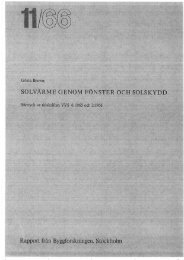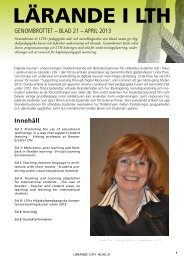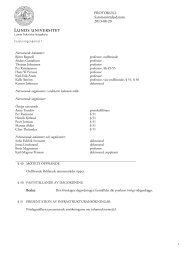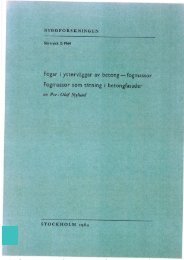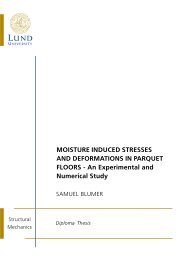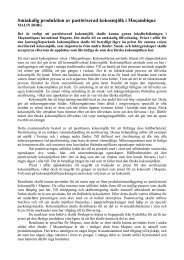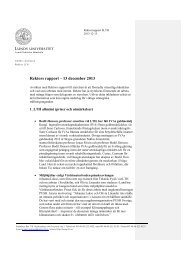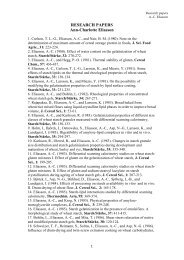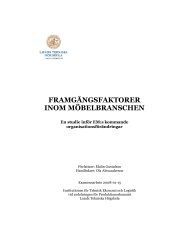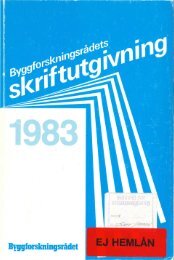User Experience Design at Sony Ericsson - Introducing the Virtual Pet
User Experience Design at Sony Ericsson - Introducing the Virtual Pet
User Experience Design at Sony Ericsson - Introducing the Virtual Pet
Create successful ePaper yourself
Turn your PDF publications into a flip-book with our unique Google optimized e-Paper software.
8. Discussion<br />
One of <strong>the</strong> objectives of this paper was to introduce <strong>the</strong> concept of a virtual pet. As <strong>the</strong> applic<strong>at</strong>ion was not taskbased,<br />
but r<strong>at</strong>her focused on entertaining and engaging users, <strong>the</strong> development of <strong>the</strong> concept gave valuable<br />
insights into how hard it is to expand <strong>the</strong> use quality portfolio and design for softer qualities of use. Usability -<br />
and with it <strong>the</strong> use qualities efficiency and effectiveness – still seems to have a firm grip of <strong>the</strong> human-computerinteraction<br />
research community. The reason for this appears to be obvious; <strong>the</strong>re are well-developed evalu<strong>at</strong>ion<br />
methods th<strong>at</strong> measure efficiency and effectiveness and fit very well into a design process. A design process is<br />
iter<strong>at</strong>ive, and <strong>the</strong>refore evalu<strong>at</strong>ion is one of <strong>the</strong> very cornerstones, cutting through every phase of development.<br />
Never<strong>the</strong>less, evalu<strong>at</strong>ion methods are not enough for designers to move beyond usability and into user experience<br />
design. <strong>Design</strong>ers have to have frameworks, methods and techniques so th<strong>at</strong> <strong>the</strong>y are not perplexed when faced<br />
with <strong>the</strong> task of cre<strong>at</strong>ing designs th<strong>at</strong> meet evalu<strong>at</strong>ion requirements. When designing <strong>the</strong> virtual pet concept, <strong>the</strong>se<br />
design problems were tackled by conducting a liter<strong>at</strong>ure review on virtual pet usage and general user behavior th<strong>at</strong><br />
seemed relevant to <strong>the</strong> task. As <strong>the</strong> actual design of scenarios and storyboards took place, some of this knowledge<br />
was used, but in a r<strong>at</strong>her unstructured way. Gut feelings still influenced <strong>the</strong> design of <strong>the</strong> usage scenarios and <strong>the</strong><br />
pets, since it was somewh<strong>at</strong> difficult to find support for <strong>the</strong> development of this kind of concept in <strong>the</strong> current<br />
design process. To a degree, this can be seen as <strong>the</strong> n<strong>at</strong>ure of design - it is unpredictable, intangible and sometimes<br />
irr<strong>at</strong>ional - and it is likely th<strong>at</strong> it is impossible to completely capture and frame it in a process.<br />
On <strong>the</strong> o<strong>the</strong>r hand, design can most likely be improved by deepening understanding of users, much like I did<br />
when reviewing liter<strong>at</strong>ure on user behavior. Focus on user behavior might force designers to broaden <strong>the</strong>ir<br />
expertise to incorpor<strong>at</strong>e not just human-computer-interaction, but also consumer psychology - one of <strong>the</strong><br />
found<strong>at</strong>ions of marketing. This widening could include learning how to conduct appropri<strong>at</strong>e market research. For<br />
<strong>the</strong> virtual pet concept, I tried this on my own without any prior experience, and realized th<strong>at</strong> evalu<strong>at</strong>ing softer use<br />
qualities is nothing short of problem<strong>at</strong>ic.<br />
In traditional usability engineering, it could be argued th<strong>at</strong> users are kept outside <strong>the</strong> core development of<br />
products, consulted mostly in <strong>the</strong> beginning and end of development cycles. <strong>User</strong>s’ problems are seen as input for<br />
design and users evalu<strong>at</strong>e <strong>the</strong> results, but in-between this, designers carry out most of <strong>the</strong>ir work separ<strong>at</strong>ed from<br />
users. The advantage of this might be th<strong>at</strong> <strong>the</strong> cre<strong>at</strong>ive procedures can be controlled in a design process, and<br />
management can better keep track of development so th<strong>at</strong> it follows time plans. The usability approach might<br />
work r<strong>at</strong>her well when development is focused on improving current products, or cre<strong>at</strong>ing products similar to<br />
wh<strong>at</strong> has been done earlier. However, it is questionable if <strong>the</strong> method supports <strong>the</strong> cre<strong>at</strong>ion of totally new<br />
concepts and products, <strong>the</strong>re might be significant problems when trying to innov<strong>at</strong>e through usability engineering.<br />
There have been some interesting <strong>at</strong>tempts to overcome <strong>the</strong>se problems and expand <strong>the</strong> qualities of use beyond<br />
those used in traditional usability; some of <strong>the</strong>se have been presented in this paper. The review of frameworks and<br />
evalu<strong>at</strong>ion methods conducted did not – and was not expected to – gener<strong>at</strong>e any clear solutions to <strong>the</strong> problems<br />
associ<strong>at</strong>ed with user experience design. The research field is still in its infancy, and <strong>the</strong>re is very much work to be<br />
done before <strong>the</strong>re is a usable, holistic <strong>the</strong>ory on user experience design. Never<strong>the</strong>less, it could be valuable to<br />
present some thoughts on how <strong>Sony</strong> <strong>Ericsson</strong> could proceed in <strong>the</strong>ir work while waiting for more elabor<strong>at</strong>ed<br />
<strong>the</strong>ories in this area. Below is a proposed action plan, which should be seen as something to talk about. It is<br />
mostly based on personal thoughts and ideas th<strong>at</strong> have come up during <strong>the</strong> writing of this paper.<br />
35



